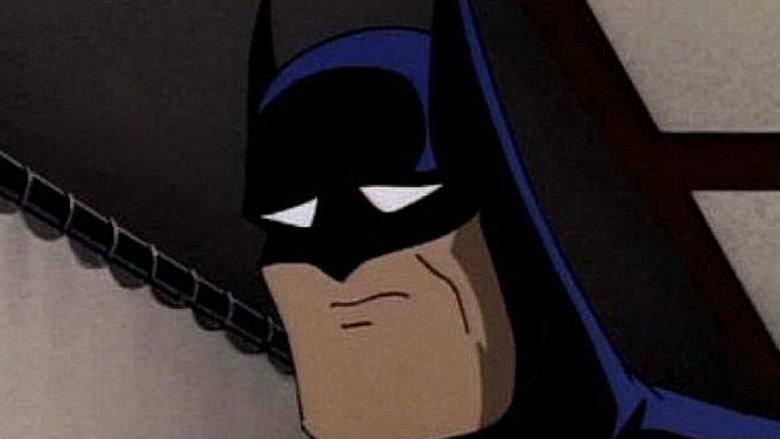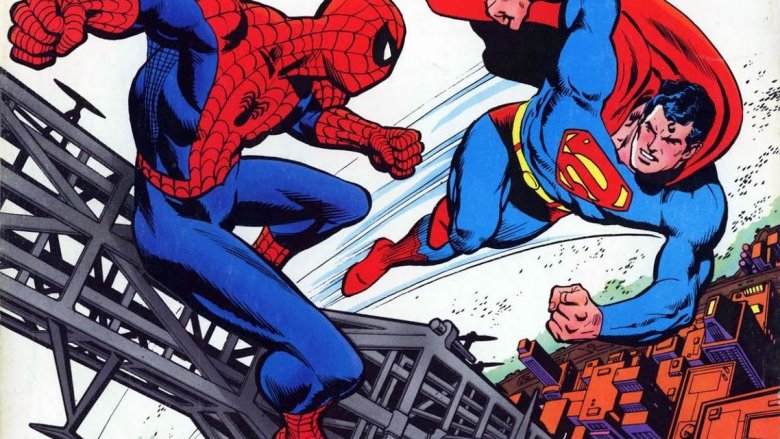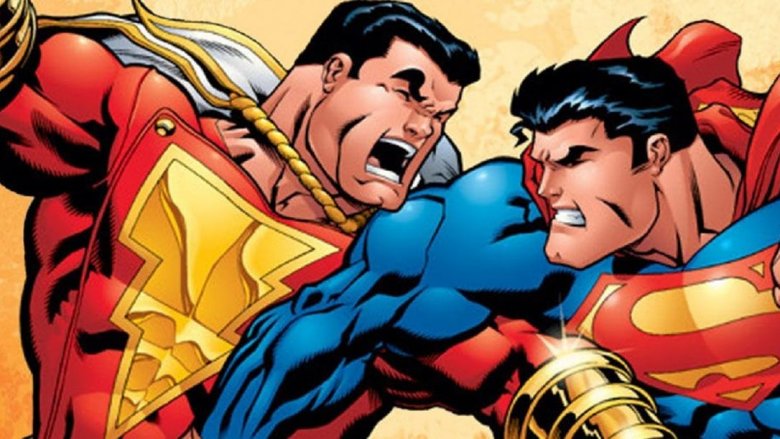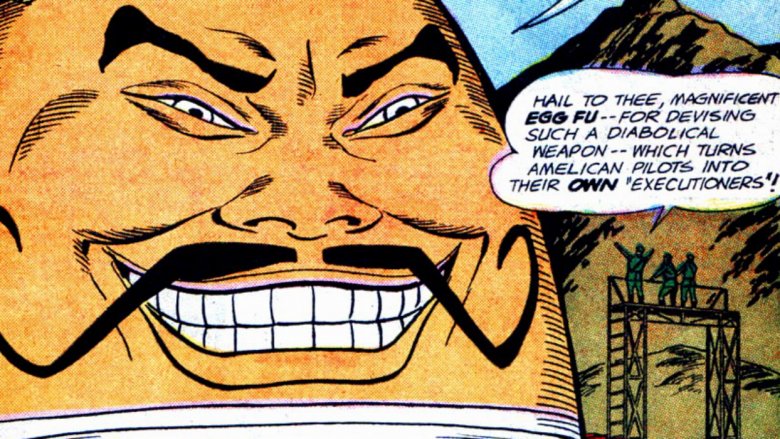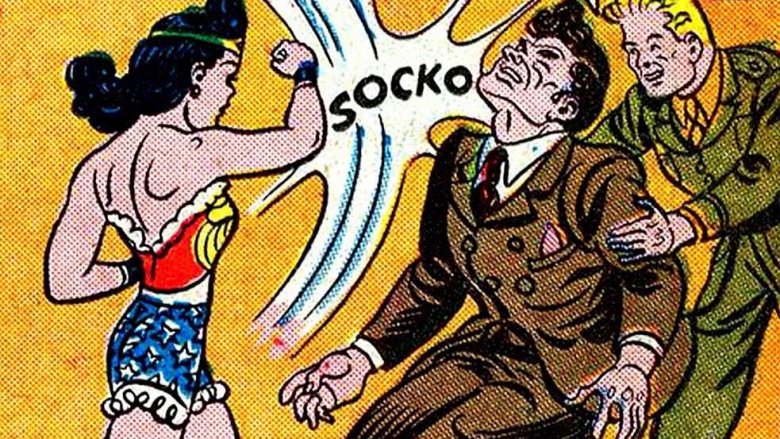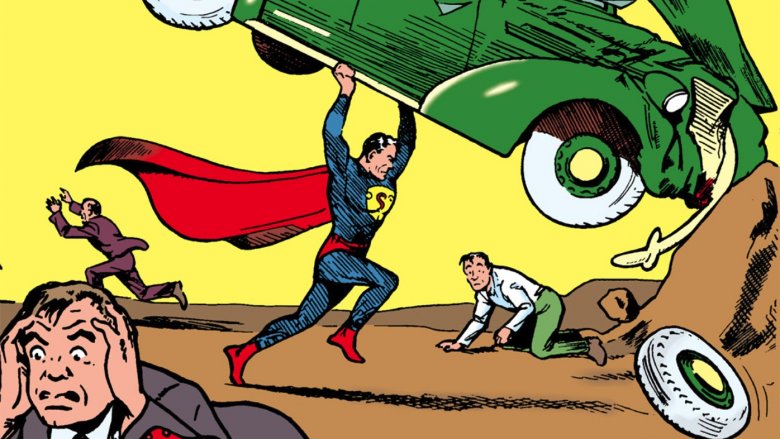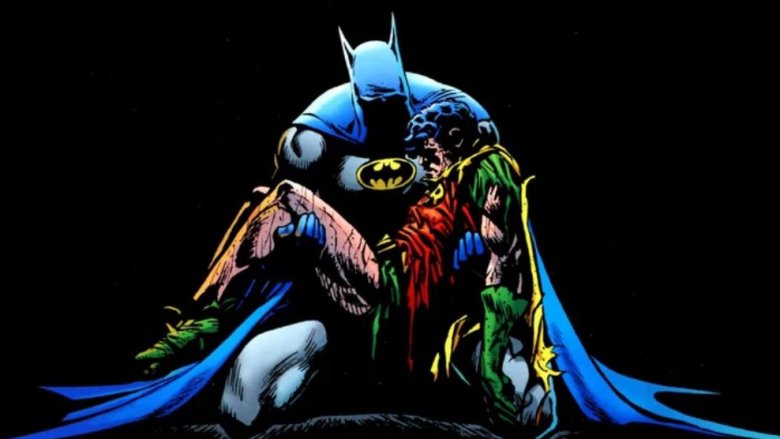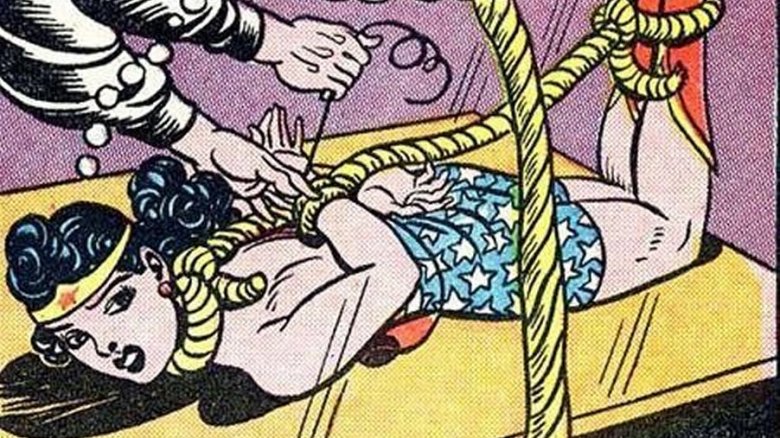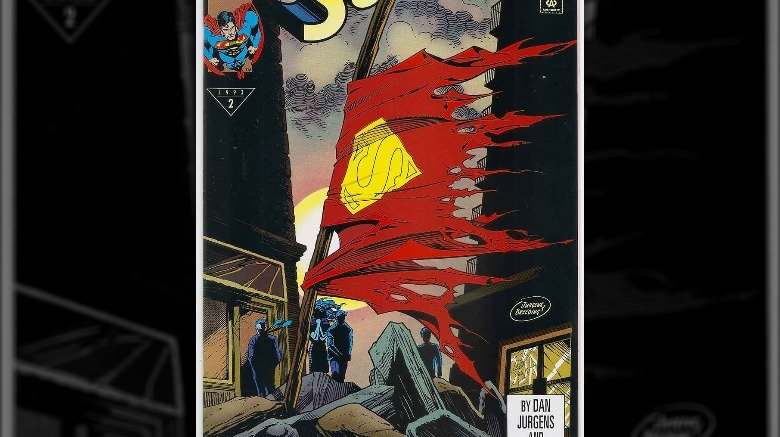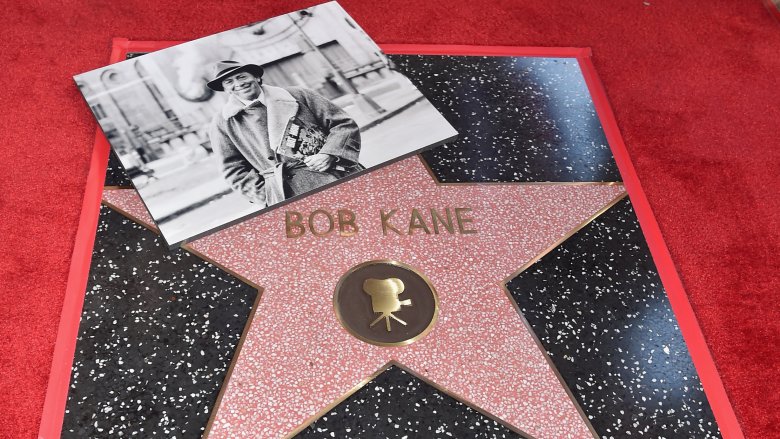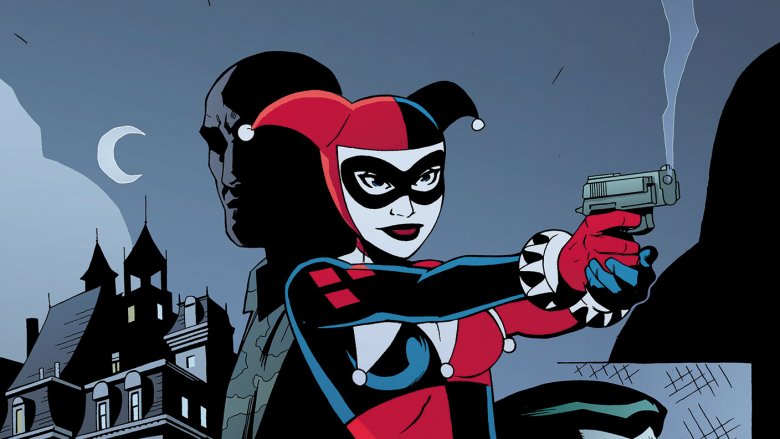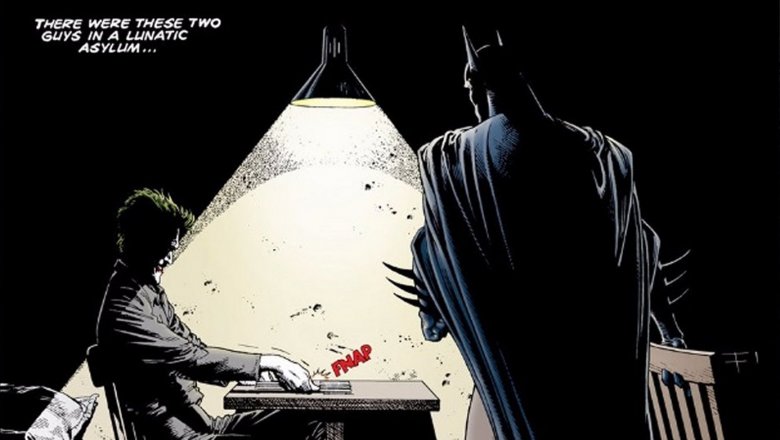Secrets DC Comics Doesn't Want You To Know
Marvel gets all the headlines, and Image is the company that creators love, but it's only fair to recognize that the superhero genre, as we know it today, is the direct result of two Jewish kids from Cleveland selling their story of a red-caped alien savior to a company named National Allied Publications. That little publisher grew to become DC Comics, the sturdy ol' grandpa of four-colored comics companies, and the home of cultural icons like Wonder Woman, Batman, and Green Arrow. Like 'em or not, you have to thank DC for all those hours you spend soaking up superheroic lore of whatever stripe.
DC certainly has an impressive legacy, from blockbuster film franchises to the seemingly endless array of superhero logo T-shirts you see at every geek convention today. However, the history of this comics giant isn't all biffs, pows, and bangs because if Batman were real, he'd probably be investigating some of the shady deals that went on behind the scenes. Here are secrets DC Comics would probably prefer you didn't know about.
DC almost got bought out by Marvel
Back in 1984, DC Comics wasn't doing so hot. While Superman, Batman, and Wonder Woman merchandise always sold big, the comic books themselves were scraping rock bottom, according to ComicBook.com. Meanwhile, Marvel was making bank (their financial troubles were still a decade away), so DC's parent company, Warner Brothers, proposed the idea of selling off DC Comics to Marvel.
Yes, this really almost happened. Yes, you could've lived in a universe where Wonder Woman/Captain Marvel team-ups and/or Superman vs. Thor events were regular occurrences. But hold on, because the story gets even crazier. According to Geek Tyrant, Marvel's president initially rejected the sale. Why? That's right, superfans, he decided that if DC's sales sucked, it was because their characters sucked. Flub of the century?
It might have been, but like any comics fan, famed Marvel editor Jim Shooter was shocked by this decision, so he swooped in and begged the president to reconsider, pointing out that DC's poor sales were due to bad writing, not bad characters. To get the ball rolling, Shooter proposed introducing the heroes to the Marvel Universe with seven starting titles: Superman, Batman, Wonder Woman, Green Lantern, Teen Titans, Justice League, and the Legion of Superheroes. (Sorry, Flash?) Marvel took up DC's offer, and negotiations began. In the end, what killed the buyout wasn't an alien invasion, a magic spell, or an asteroid, but corporate politics: Marvel's potential marketplace dominance veered a bit too close to antitrust violations, and everyone went their separate ways.
How DC stole Shazam
These days, Shazam is a DC superhero, headlining a multimillion-dollar blockbuster. The way he got there, though? Not so heroic.
When Superman first hit news stands in 1939, every publisher in the nation suddenly wanted their own superhero. One of the early successes was Billy Batson, a young boy who uttered the word "Shazam!" to become a full-grown powerhouse named Captain Marvel. Batson's stories were printed by a company called Fawcett Comics, as Newsarama points out, and the so-called "Big Red Cheese" comics not only outsold Superman, but also inspired the first live-action superhero adaptation ever. While it's nice to imagine a world where DC (then National) would've just enjoyed the competition, the company instead sued Fawcett to the ground, alleging that Captain Marvel was a copyright-violating Superman ripoff.
Fawcett won the case in 1951, but DC appealed, winning a retrial in 1952. Fawcett probably could've given it another go, but by this time superhero sales had gone kaput, so they gave up. The name Captain Marvel got scooped up by Marvel Comics in the 1960s, according to Gizmodo, while the Batson character languished until 1972 ... whereupon the rights were bought by, you guessed it, DC Comics, who eventually renamed him "Shazam" to avoid copyright issues with Marvel.
Racism and prejudice problems
There are a lot of great things about the United States, but the cloud of racism, prejudice, and xenophobia that has existed since the country's formation is definitely not one of them. While most media forms have a history of racism roughly mirroring the culture, the comics industry has sometimes come out ahead: considering that the entire superhero genre was the brainchild of Jewish creators striking out against the Nazis, it makes sense that comics have usually tried to fight back against prejudiced attitudes. Sadly, though, there have been numerous occasions where outdated cultural attitudes toward minority groups have poisoned the art form, DC Comics included.
To start with, DC's propaganda covers in World War II include some cartoonishly racist depictions of the Japanese. Shift ahead to the 1960s, and you'll find more than a few characters who comic book creators wish you'd forget, including Egg Fu (a bundle of Asian prejudices packed into an oval-shaped body) and Extraño, a walking gay stereotype. Perhaps the worst example of all is the whole Legion of Superheroes incident where a DC editor forced the creators to develop an ill-conceived storyline about racial separatism in the far future: the featured character, "Tyroc," was so outlandishly racist that the artist, Mike Grell, deliberately drew him in the dumbest costume he could envision in hopes that no one would ever take the character seriously.
Sexual harassment
There's been a lot of focus on Hollywood and politics lately, but the truth is just about every industry and workplace in the country has a dark history of sexual harassment, abuse, and problematic power dynamics, which woman have struggled against for centuries. Comics are no exception, and perhaps the most noteworthy figure to receive promotions, despite a known history of sexual abuse, is former DC editor Eddie Berganza.
According to Vox, the long and tangled trail of allegations against Berganza was largely swept aside for years as he rose through the ranks. By the time Berganza became the company's executive editor in 2010, any female DC staffers who reported his actions to HR were removed, leading to even more female comic creators avoiding DC Comics entirely. By 2012, an incident involving Berganza at WonderCon was criticized by enough people that DC demoted him to the still-prominent position of group editor for the Superman titles. This didn't change his behavior, as a 2017 BuzzFeed report showed multiple women coming forth with sexual assault allegations against him, throughout which DC had apparently never acted disciplined him. At this point, the company suspended Berganza, and finally fired him after an internal review.
The long legal battle against Superman's creators (and family)
Back in the 1930s, according to the Times of Israel, two nerdy young men named Jerry and Joe — still living with their parents — had the grand idea of a story about an alien baby, doomed to death, being rocketed to Earth, where his amazing powers and moral resolve would make him this world's champion. Great concept, and one of the most influential in American culture, but when DC Comics agreed to print their story, they had no idea what was on their hands. No one did. So they sold all the rights for Superman to DC Comics ... for $130. Big whoops. Decades later, as DC profited from cartoons, toys, and blockbuster films, Joe Shuster and Jerry Siegel faced situations ranging from eviction threats to medical debt, and though both men did make a decent amount of money in the end, it certainly wasn't their fair share.
According to Ars Technica, the duo first sued the comics company all the way back in 1947, reaching a settlement that earned them the royalty payments (and credit for the hero's creation) that continued throughout their lives. The legal battles didn't die with them, though. In the 2000s, their families mounted a legal battle against the comics giant, arguing that a 1978 change in copyright law should allow more rights over the character. After multiple trials, appeals, and so on, DC/Warner Brothers won the case in 2014.
They cheated Alan Moore and Dave Gibbons out of Watchmen
To be fair, nobody saw Superman coming, or could've foreseen how meager that $130 payment would someday seem. Watchmen, on the other hand? That happened in the 1980s, and what DC did to the book's creators was sneaky as hell. According to Watchmen's outspoken author, Alan Moore, when he and artist Dave Gibbons first crafted the series, the publisher presented themselves as a "new DC Comics" and offered a deal: Once Watchmen went out of print, the rights would revert back to the creators. Moore and Gibbons enthusiastically signed the dotted line, but unfortunately, DC had another plan in mind. To make sure Moore and Gibbons never got the rights back, the publisher has ensured that Watchmen, to this day, has never gone out of print.
As Moore tells it, in a later interview, this isn't even the most immoral thing the company has done to him. He claims DC attempted to blackmail him (by employing and then firing a friend with a dying brother) to remain "quietly compliant" about new Watchmen-related works, rather than publicly divorcing himself from (or speaking out against) said projects, as he would prefer to do. Though Moore will forever be remembered for producing some of DC's most iconic works, it's no surprise that he refuses to ever work for the company again.
The fans (maybe) didn't actually kill Robin
Back in 1988, the second Robin — a violent kid named Jason Todd — was garnering a lot of criticism from fans, who still missed Richard Grayson. So legendary Batman writer Denny O'Neil had a clever idea: He ended a story with Robin's fate in the balance and listed two phone numbers for all the readers: Calling one number would be a vote for Robin's life to be spared, and the other number would be a vote to kill him.
The results were tight. By a margin of only 72 votes, Jason Todd bit the dust.
However, this close margin has inspired a lot of doubts over the years. After all, rigging a 1980s phone poll is child's play, and a 1988 New York Times piece even interviewed one fan who admitted to voting 10 times to save Robin, and says he would've voted more if he'd known how close it would be. As it happens, O'Neil himself has expressed doubt regarding the results, even saying he'd heard stories about one anti-Robin voter programming his phone to dial the death number every 90 seconds for eight hours to make sure the Boy Wonder got snuffed out. He didn't have any evidence, but still ... yikes.
So did fans really kill Robin? Nobody knows. However, it's not entirely impossible that some bloodthirsty comics fan might still be alive today, clad in Joker makeup, reading this and snickering to themselves.
Frank Miller almost did a Wonder Woman bondage project
Wonder Woman is one of the most inspirational superheroes out there. Feminist philosophy played a key role in the character's creation, and she's been a symbol of empowerment for three-quarters of a century, only becoming more popular since the 2017 Gal Gadot film.
In retrospect, now that Diana Prince is bigger than ever, DC is probably glad they didn't pull the trigger on that weird "Wonder Woman: Bondage" comic that Frank Miller wanted to write in his post-Dark Knight Strikes Again days. The only material ever developed for the project were a number of rather exploitative drawings of the heroine, but according to Comic Book Resources, Miller did have discussions with DC editor Bob Schreck about the project, which would have re-envisioned Diana and her origin in a very NSFW way. The character's creator, William Moulton Marston was a radical feminist who liked that sort of thing as a "metaphor for the many ways in which women were collectively and individually constrained by law and 'tied down' by marriage, domesticity, children, and all the rest of it." Perhaps the broader comics audience at the time wouldn't have picked up on that message. It's probably a good thing that we stayed away from a deep dive into that metaphor.
Superman's death was written to accomodate a TV show
"The Death of Superman," back in the 1990s, might be the ultimate example of a comic book forcing readers to go big or go home. A sprawling epic that showed the Man of Steel perishing against a monstrous foe named Doomsday, followed by a mad scramble for inheritors to claim his legacy, has become one of the all-time classic Kal-El stories to date. The reason it all happened, though, is pretty humorous.
As SyFy explains, the last decade of the 20th century wasn't a good time for Superman sales, as the inspirational Kryptonian hero languished against darker, flashier rebels like Wolverine and the Punisher. DC's Superman line needed a big event, so they decided to finally have Clark Kent and Lois Lane get hitched. Great! But right before the Daily Planet reporters could say "I do," a little TV show named Lois & Clark: The New Adventures of Superman came out, putting a heavy focus on the romance and making it seem unwise to have the simmering soap opera heroes on TV be happily married in the comics. Besides that, why resist the lure of having the TV Clark and Lois get married at the same time as the comic versions? So the wedding was postponed and the Superman writers needed a new massive event to fill the empty space. Writer Jerry Ordway allegedly joked "Let's kill him!" ... and suddenly, comics history was forever changed.
Bob Kane didn't create Batman by himself
Find a random person on the street with a passing knowledge of comics, ask them who created Batman, and they'll probably say it was Bob Kane. As Fast Company points out, though, that's a sinister lie worthy of a stint in Blackgate Penitentiary. While Bob Kane certainly came up with the name "Bat-Man," his original concept — of a red-shirted, domino-masked blonde dude with real bat wings — was dramatically different from the character refined by his coworker, Bill Finger, the man who really deserves a huge amount of the credit. According to Wired, Finger created most of the iconic features of the Dark Knight today, including his wealthy alter-ego Bruce Wayne, his origin story, Gotham City, and many of the major villains, including Joker, Penguin, and Catwoman. Despite this, Bob Kane took all the credit, with a particularly notorious example being the creator's self-aggrandizing tombstone, which refers to Batman as a "Hand of God" creation that was divinely bestowed upon Kane.
In recent years, Finger's name has finally started popping up in Batman films, comics, and media, but that doesn't excuse DC's long history of giving Kane all the credit, including one particularly dishonest 1946 comic that was created purely to teach kids a false narrative about Batman's creation.
The Harley Quinn suicide controversy
In 2013, DC put out an "Open Talent Search" where unknown artists could submit illustrations, based on a prompt, for a chance to draw one page of an upcoming Harley Quinn comic, according to Newsarama. Awesome opportunity, right? Great promotion, great exposure ... but there was problem. Namely, the prompt asked submitters to draw a picture of Harley lying naked in a bathtub and "humorously" considering various suicide methods.
Not surprisingly, this combination of suicide ideation and overt sexuality didn't sit well with the American Psychiatric Association, the American Foundation for Suicide Prevention, or the National Alliance on Mental Illness, all of whom spoke out against the publisher. DC quickly backtracked, claiming the page description was taken out of context and was not intended to make light of suicide.
If you or anyone you know is having suicidal thoughts, please call the National Suicide Prevention Lifeline at 1-800-273-TALK (8255).
Alan Moore isn't a fan of The Killing Joke
There are a lot of great Batman stories out there, but The Killing Joke — by Alan Moore and Brian Bolland — is widely credited as the definitive Joker tale of all-time. Most Batman writers, in any medium, hail the story. One author who isn't a fan, though, is Alan Moore himself, according to Inverse.
Moore routinely blasts the comic whenever he's asked about it. The reason for this, essentially, is that Moore now believes the story he wrote was far too gruesome, weighty, sexualized, and violent for (in his words) a "simplistic comic book character like Batman." He regards the whole thing as a terrible misstep. Although Moore wrote dark stories, like Watchmen and Marvelman, he claims he never intended for other comic writers to follow his lead. Though Moore admits to no longer having any interest in the Batman character, he does say if he were to re-approach the caped crusader today, he would prefer to write the colorful, smiling version of Batman from the 1950s and 1960s. To be fair, though, Moore has said several times that he's not even a fan of the superhero genre anymore, according to SyFy, and his dislike for his own story doesn't change The Killing Joke's immense impact on popular culture, particularly in regard to inspiring Heath Ledger's performance in The Dark Knight.
